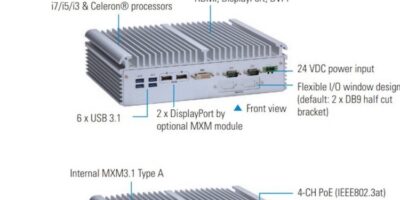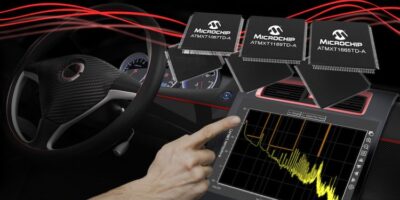For applications in machine vision, edge computing, traffic vision, deep learning, and artificial intelligence (AI) of things, the eBOX671-521-FL is a graphics processing unit (GPU) computing embedded system with four-channel PoE and a MXM 3.1 Type A slot.
The eBOX671-521-FL is powered by the 8th gen Intel Core i7, i5, i3 (Coffee Lake-S) processor with either up to six-core, Intel Pentium processor, or Intel Celeron processor and comes with Intel Q370 or optional Intel C246 chipset.
The fanless embedded GPU-based system is equipped with dual DDR4 error code correction (ECC) /non-ECC SO-DIMM slots for up to 64Gbyte of system memory. The embedded vision system has an optional MXM type A slot for NVIDIA GTX1030 and GTX1050 graphics modules to enhance the performance of the visual display.
The Intel Coffee Lake-based embedded box PC is designed with four Gigabit 802.3at (Power-over-Ethernet or PoE) -compliant Ethernet ports with a power budget of 60W, six USB 3.1 ports and two Gigabit LANs to connect different devices or sensors.
“Axiomtek’s eBOX671-521-FL is dedicated to AI inference, GPU computing, and machine learning and image processing,” explains Janney Lee, a product manager of Product PM Division at Axiomtek. In addition to the expansion options of an internal MXM 3.1 type A connector, two full-size PCI Express Mini Card slots and two SIM slots, there are two swappable SATA HDD drive bays with a height of up to 9.5 mm and one mSATA for RAID 0 and 1 feature, for storage. Lee continues: “We have designed a flexible I/O window slot for incorporating application-oriented I/O functions to meet the requirements of various cases. This embedded vision computer can be mounted using wall or DIN-rail mounting for versatile use in various environments.”
I/O interfaces include two RS-232/422/485, one DVI-I port, one HDMI port, one VGA port, and two DisplayPort outputs through an optional MXM graphics kit. There is also a Phoenix-type VDC power input connector, AT/ATX quick switch, ATX power switch, reset switch, and four SMA-type antenna openings. The four-channel Gigabit PoE embedded vision system supports a 24V DC power input with power protection.
The eBOX671-521-FL supports Windows 10 IoT and Linux operating systems and supports Axiomtek’s AXView 3.0 software for smart device monitoring and remote management in the industrial IoT world.







